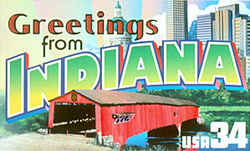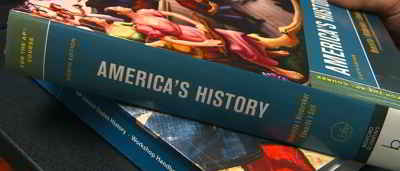

Indiana History Timeline
Important Dates, Events, and Milestones in Indiana History
Offers a chronological timeline of important dates, events, and milestones in Indiana history.Prehistoric Native Americans arrive in the area that would be Indiana around 11,000BCE. Some of the prehistoric people are hunters-gatherers while others are farmers. They leave behind mounds that were used as burial sites, temples, platforms for religious structures, and earthen forts. When European explorers enter the region, only a few hundred Native Americans remain. Most belong to the Miami tribe Indiana sits, as its motto claims, at "the crossroads of America."
Indiana borders Lake Michigan and the state of Michigan to the north, Ohio to the east, Kentucky to the south, and Illinois to the west, making it an integral part of the American Midwest. Except for Hawaii, Indiana is the smallest state west of the Appalachian Mountains. Indiana was admitted on Dec. 11, 1816, as the 19th state of the union
17th Century Indiana History Timeline
1614,1615 - Samuel de Champlain, governor of New France and the founder of Quebec, was believed to be the first of the French explorers to be connected with the Maumee region. He is believed to have seen the Maumee in 1614 or 1615.
1671 - Simon Daumont de Saint-Lusson declared the lands of the western interior for France at Sault Ste. Marie. Louis Jolliet was one of the signers of this declaration which included the area that later became Indiana. Rene-Robert Cavelier de La Salle (1643-1687) enters the area that was to become Indiana.
1679 - Rene-Robert Cavelier de La Salle (1643-1687) & Louis de Baude de Frontenac, Governor of New France, decided on plans which would enable them to gain control of the area enabling the Maumee-Wabash trade route (via the portage of 1670). One part involved relocating the Miami Indians to the headwaters of the Maumee River to secure the area. This Miami village, located at the site of the present city of Fort Wayne, was known as Kekionga, or Kiskakon, and later became known as "Miamitown". It was used as a trading post by 1686, and is reported to be "the oldest continually occupied community in subsequent Indiana and the general area to the south of the Great Lakes.
1689-1697 - King William's War
18th Century Indiana History Timeline
1702-1713 - Queen Anne's War
1702 - A major transportation complex of the midwest, the territory that is now known as Indiana was first explored by the French. Mostly fur traders, they established the first permanent settlement at Vincennes
1717 - French Fort Quiatenon was established, near the present city of Lafayette, to protect the western frontier
1721 -
- Fort Philippe, later called Fort Miami, was built on the St. Mary's River, near the area in Fort Wayne, where the St. Mary's, St. Joseph's and Maumee Rivers meet.
- Pierre Charlevois describes the Miami Indian game which is the ancestor of the modern game of LaCrosse.
1732 - Vincennes fortified in 1732 and Vincennes becomes the Indiana's first permanent settlement
1744 - King Nicolas War (known as "King George's War" in Europe) began.
1747 - British influenced Huron chief, King Nicolas, attacking the French Fort Miami.
1749 - Second French fort
1752, 1753 - A smallpox plague struck the Indian population causing dramatic loss of life.
1754-1763 - The French and Indian War
1763 - England gains control of the Indiana region and Vincennes The proclamation of 1763 forbid the settlement of lands west of the Appalachian Mountains. From their posts north of the Ohio River the British sent Indian war parties against those settlers who ignored the proclamation line.
1772 -General Gage ordered the French in the Wabash Valley to leave their settlements, & demanded the title deeds to their lands.
1774 - (June 2nd) British Parliament passed the Quebec Act, permitting the Canadians to retain French laws and customs, and allowing the Catholic Church to maintain all its rights. "The French settlements at the West, in our present Michigan, Indiana, Illinois and Wisconsin, were by the act included in the province of Quebec."
1776-1787 - The Revolutionary War
1777 - Indians on the Trans-Appalachian Frontier were encouraged by the British to attack the frontier Americans.
1778 -
- (Summer) An expedition from Virginia, headed by Colonel George Rogers Clark proceeded down the Ohio River, then went on to capture the British posts at Kaskaskia and Cahokia along the Mississippi River, near St. Louis. Although under British rule after the French and Indian War, these posts were populated by French settlers that had no great affection for the British. Clark quickly gained their support. Father Pierre Gibault and Dr. Jean Laffont volunteered to travel to Vincennes on behalf of the Americans and soon that settlement also gave its support to Clark. The French at Detroit and other northern posts however, maintained the outward support of the British.
- British Gov. Henry Hamilton retook Fort Sackville
- Francis Vigo (born in Italy in 1747) rendered aid to Clark and the Americans which helped Clark to gain the surrender of Fort Sackville in 1779.
1779 - British Lieutenant-Governor Henry Hamilton surrendered Fort Sackville to American Colonel George Rogers Clark
1783 - Indiana area given to the United States Territory. "Declaration Signed in Paris by the American Commissioners - February 20,
1783 By the Ministers Plenipotentiary of the United States of America, for making Peace with Great Britain. A Declaration of the Cessation of Hostilities
as well by Sea as Land, agreed upon between His Majesty, the King of Great Britain, and the United States of America..."
The British Province of Quebec lost all the lands below the Great Lakes with the signing of the 1783 Treaty.
1787-1800 - The Northwest Territory
1787 - Treaty of Fort Harmer was signed, and a war began in the summer which would last until 1794.
1794 -
- John Jay obtained the signing of a Treaty with England which provided that British should withdraw troops from posts within the boundaries of the United States by 1 June 1796.
- Tecumseh led the Shawnee Indians in the battle near the rapids of the Maumee. Anthony Wayne overwhelmed the Indians.
- Anthony Wayne establishes a Fort at Kekionga, and names it "Fort Wayne".
19th Century Indiana History Timeline
1800-1816 - The Indiana Territory
- Indiana Territory was established from the Northwest Territory with William Henry Harrison (1773-1841) as the first Governor and Vincennes the capital.
1803 - Potawatomi and others signed treaties at Fort Wayne, Fort Industry (1805), and Grouseland (1805), ceding portions of Ohio, Indiana, and Illinois..."
1804 -
- Elihu Stout printed the laws of the Territory, and the "Indiana Gazette".
- Vincennes, the capital of the Indiana Territory, also served as the capital of the Louisiana Purchase for nine months in 1804.
- Elihu Stout printed the laws of the Territory, and the "Indiana Gazette".
1805 - Michigan Territory separated from the Indiana Territory.
1809 - Illinois Territory separated from the Indiana Territory.
1811 - Indians are defeated in the Battle of Tippecanoe under W. H. Harrison
1811-1812 - Earthquakes in the midwest
1813 - Territorial Capital moved to Corydon.
Michikinikwa (Chief Little Turtle) died in Fort Wayne July 14, 1812.
1814 - The War of 1812 which ended 24 December 1814 with signing of the Treaty of Ghent July 22, 1814: "A treaty of peace and friendship between the United States of America, and the tribes of Indians called the Wyandots, Delawares, Shawanoese, Senecas, and Miamies..."
September 8, 1815: Treaty between the United States of America and the Wyandot, Delaware, Seneca, Shawanoe, Miami, Chippewa, Ottawa, and Potawatimie, Tribes of Indians, residing within the limits of the State of Ohio, and the Territories of Indiana and Michigan
1816 - Indiana becomes the 19th state with the capitol at Corydon. Jonathan Jennings (1784-1834) was the first Governor of Indiana.
1818 - St. Marys, Ohio, several Indian tribes (Delawares, Wea, Kickapoos, Miamis and Potawatomis) gave up their claim to a portion of central Indiana, called the "New Purchase."
1822 - Indiana and Illinois joined together in a plan to connect the Maumee and Wabash Rivers, and in 1826, the canal became a reality, with the first section, linking Fort Wayne with Huntington, completed in 1835.
1825 - Indianapolis becomes the state capital
1842 - The University of Notre Dame is founded in South Bend
1851 - Indiana adopted a state constitution that included a measure protecting the property rights of married women.
1889 - The Standard Oil Company builds an oil refinery in Whiting
1897 - Tribal status of the Indiana Miami was terminated, however there were still 90 Miami listed on the 1910 census of Indiana.
20th Century Indiana History Timeline
1906 - US Steel Company builds steel plant and founds the city of Gary
1911 - The first Indy 500 car race takes place
1915 - Workmen's Compensation Act becomes law
1932 - One-fourth of the workforce was unemployed.
1956 - The Northern Indiana Toll Road is completed.
1963 - Studebaker Automobile Corporation ceased auto production at South Bend plant
1974 - Series of 148 tornadoes struck the Midwest and Southern states (including Indiana -; many killed with severe property damage
1980 - Indianapolis businessman, Herbert Baumeister, killed 16 men, most gay
1984 - NFL Baltimore Colts moved to Indianapolis
1985 - AIDS patient, Ryan White, barred from attending public school
1987 - Air Force jet crashed into Ramada Inn near Indianapolis Airport, ten killed
1988 - Indianian J. Danforth Quayle, elected U. S. Vice President
1998 - Explosion at Southern Energy Co. in Hammond killed 16
1999 - Lilly Endowment Inc. presented $50 million grant to Hispanic Scholarship Fund
21st Century Indiana History Timeline
2001 -
- Cicero's town president, nine others, charged with stealing $10 million in taxpayer monies;
- Oklahoma City bomber, Timothy McVeigh, executed at Federal Penitentiary in Terre Haute
2003 - Governor Frank O'Bannon suffered massive stroke, died
2004 - Indianapolis Colts' Peyton Manning broke Dan Marino's pass record
2005 - Measles outbreak among school children; tornado struck Evansville, 22 killed, 200 injured
2007 - Indianapolis Colts won Super Bowl XLI
2010 - Eight teenagers shot at skating rink during concert in Gary
2011 - Five people killed, more than 40 injured in stage collapse at Indiana State Fair
2012 - Series of powerful storms and tornadoes left 13 dead, destroyed town of Marysville






